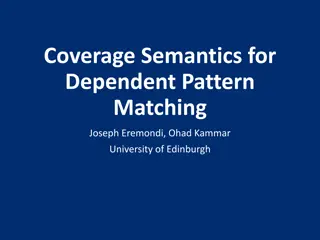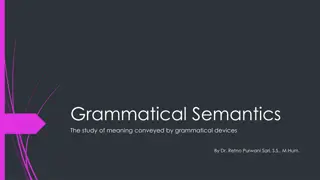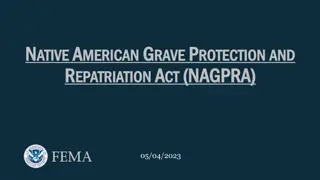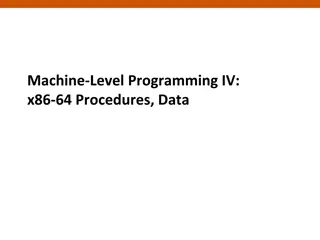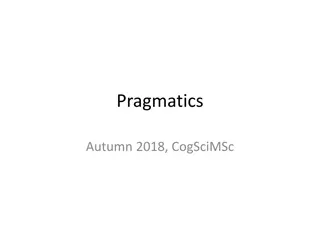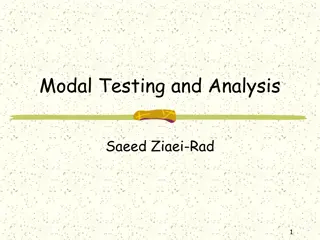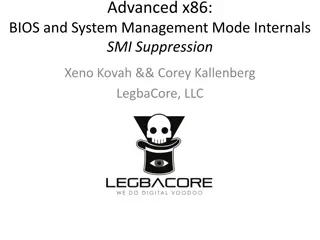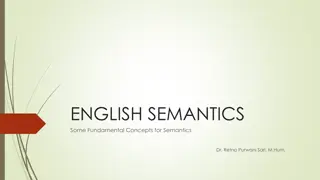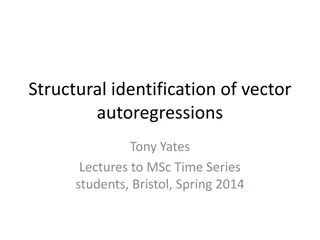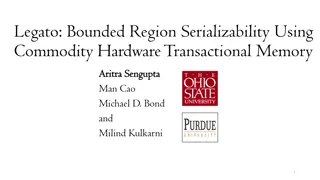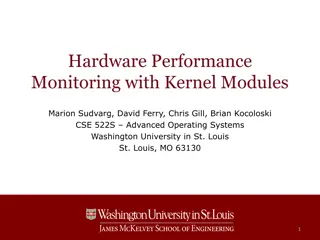Native x86 Decompilation with Semantics-Preserving Structural Analysis
Decompilers play a crucial role in software security by reverse-engineering compiled programs to uncover bugs and vulnerabilities. The quest for high-level control flow structure and types drives the application of decompilation techniques. Effective abstraction recovery enhances comprehension and aids in bug identification. Explore the process of iterative control-flow structuring and structural analysis in x86 decompilation.
Download Presentation

Please find below an Image/Link to download the presentation.
The content on the website is provided AS IS for your information and personal use only. It may not be sold, licensed, or shared on other websites without obtaining consent from the author.If you encounter any issues during the download, it is possible that the publisher has removed the file from their server.
You are allowed to download the files provided on this website for personal or commercial use, subject to the condition that they are used lawfully. All files are the property of their respective owners.
The content on the website is provided AS IS for your information and personal use only. It may not be sold, licensed, or shared on other websites without obtaining consent from the author.
E N D
Presentation Transcript
Native x86 Decompilation Using Semantics-Preserving Structural Analysis and Iterative Control-Flow Structuring Edward J. Schwartz*, JongHyup Lee, Maverick Woo*, and David Brumley* Carnegie Mellon University * Korea National University of Transportation
Which would you rather analyze? Functions Types push %ebp mov %esp,%ebp sub $0x10,%esp movl $0x1,-0x4(%ebp) jmp 1d <f+0x1d> mov -0x4(%ebp),%eax imul 0x8(%ebp),%eax mov %eax,-0x4(%ebp) subl $0x1,0x8(%ebp) cmpl $0x1,0x8(%ebp) jg f <f+0xf> mov -0x4(%ebp),%eax leave ret int f(int c) { int accum = 1; for (; c > 1; c--) { accum = accum * c; } return accum; } Variables Control Flow 8/15/13 Usenix Security 2013 2
int f (int x) { int y = 1; while (x > y) { y++; } int f (int a) { int v = 1; while (a > v++) {} return v; return y; Original Source Recovered Source 010100101010101 001010110111010 101001010101010 101111100010100 010101101001010 100010010101101 010101011010111 Compiled Binary 8/15/13 3
Decompilers for Software Security Manual reverse-engineering Traditional decompiler application Apply wealth of existing source-code techniques to compiled programs[Chang06] Find bugs, vulnerabilities Heard at Usenix Security 2013, during Dowsing for Overflows We need source code to access the high-level control flow structure and types 8/15/13 Usenix Security 2013 4
Desired Properties for Security 1. Effective abstraction recovery Abstractions improve comprehension 8/15/13 Usenix Security 2013 5
Effective Abstraction Recovery s1; while (e1) { if (e2) { break; } s2; } s3; More Abstract s1; L1: if (e1) { goto L2; } else { goto L4; } L2: if (e2) { goto L4; } L3: s2; goto L1; L4: s3; Less Abstract 8/15/13 Usenix Security 2013 6
Desired Properties for Security 1. Effective abstraction recovery Abstractions improve comprehension 2. Correctness Buggy(Decompiled) Buggy(Original) 8/15/13 Usenix Security 2013 7
Correctness int f (int x) { int y = 1; while (x > y) { y++; } int f (int a) { int v = 1; while (a > v++) {} return v; return y; Original Source Recovered Source Are these two programs semantically equivalent? 010100101010101 001010110111010 101001010101010 101111100010100 010101101001010 100010010101101 010101011010111 Compiled Binary 8/15/13 8
Prior Work on Decompilation Over 60 years of decompilation research Emphasis on manual reverse engineering Readability metrics Compression ratio: 1 ??? ?????????? ??? ???????? Smaller is better Little emphasis on other applications Correctness is rarely explicitly tested 8/15/13 Usenix Security 2013 9
The Phoenix C Decompiler 8/15/13 Usenix Security 2013 10
How to build a better decompiler? Recover missing abstractions one at a time Semantics preserving abstraction recovery Rewrite program to use abstraction Don t change behavior of program Similar to compiler optimization passes 8/15/13 Usenix Security 2013 11
Semantics Preservation Abstraction Recovery s1; L1: if (e1) { goto L2; } else { goto L4; } L2: if (e2) { goto L4; } L3: s2; goto L1; L4: s3; s1; while (e1) { if (e2) { break; } s2; } s3; Are these two programs semantically equivalent? 8/15/13 Usenix Security 2013 12
How to build a better decompiler? Recover missing abstractions one at a time Semantics preserving abstraction recovery Rewrite program to use abstraction Don t change behavior of program Similar to compiler optimization passes Challenge: building semantics preserving recovery algorithms This talk Focus on control flow structuring Empirical demonstration 8/15/13 Usenix Security 2013 13
Phoenix Overview 010100101010101 001010110111010 101001010101010 101111100010100 010101101001010 100010010101101 010101011010111 Type Recovery CFG Recovery int f (int x) { int y = 1; while (x > y) { y++; } Control Flow Structuring Source-code Output return y; New in Phoenix 8/15/13 Usenix Security 2013 14
Control Flow Graph Recovery e e 010100101010101 001010110111010 101001010101010 101111100010100 010101101001010 100010010101101 010101011010111 CFG Recovery Vertex represents straight-line binary code Edges represents possible control-flow transitions Challenge: Where does jmp %eax go? Phoenix uses Value Set Analysis [Balakrishnan10] 8/15/13 Usenix Security 2013 15
Type Inference on Executables (TIE) [Lee11] How does each instruction constrain the types? movl (%eax), %ebx Constraint 1: %eax is a pointer to type <a> Constraint 2: %ebx has type <a> Solve all constraints to find <a> 8/15/13 Usenix Security 2013 16
Control Flow Structuring 8/15/13 Usenix Security 2013 17
Control Flow Structuring if (e) { ;} else { ;} e e Compilation if (e) { ;} else { ;} e e Control Flow Structuring 8/15/13 Usenix Security 2013 18
Control Flow Structuring: Don t Reinvent the Wheel Existing algorithms Interval analysis [Allen70] Identifies intervals or regions Structural analysis [Sharir80] Classifies regions into more specific types Both have been used in decompilers Phoenix based on structural analysis 8/15/13 Usenix Security 2013 19
Structural Analysis Iteratively match patterns to CFG Collapse matching regions B1 B1 B2 B3 B2 while if-then-else Returns a skeleton: while (e) { if (e ) { } } 8/15/13 Usenix Security 2013 20
Structural Analysis Example WHILE ITE 1 SEQ 1 SEQ ...; while (...) { if (...) {...} else {...} }; ...; ...; 8/15/13 Usenix Security 2013 21
Structural Analysis Property Checklist 1. Effective abstraction recovery 8/15/13 Usenix Security 2013 22
Structural Analysis Property Checklist 1. Effective abstraction recovery Graceless failures for unstructured programs break, continue, and goto statements Failures cascade to large subgraphs 8/15/13 Usenix Security 2013 23
Unrecovered Structure s1; while (e1) { if (e2) { break; } s2; } s3; Original Iterative Refinement s1; L1: if (e1) { goto L2; } else { goto L4; } L2: if (e2) { goto L4; } L3: s2; goto L1; L4: s3; Decompiled Fix: New structuring algorithm featuring SEQ UNKNOWN This break edge prevents progress 8/15/13 Usenix Security 2013 24
Iterative Refinement Remove edges that are preventing a match Represent in decompiled source as break, goto, continue Allows structuring algorithm to make more progress 8/15/13 Usenix Security 2013 25
Iterative Refinement s1; while (e1) { if (e2) { break; } s2; } s3; Decompiled s1; while (e1) { if (e2) { break; } s2; } s3; Original WHILE SEQ BREAK SEQ 1 8/15/13 Usenix Security 2013 26
Structural Analysis Property Checklist 1. Effective abstraction recovery Graceless failures for unstructured programs break, continue, and gotos Failures cascade to large subgraphs 2. Correctness 8/15/13 Usenix Security 2013 27
Structural Analysis Property Checklist 1. Effective abstraction recovery Graceless failures for unstructured programs break, continue, and gotos Failures cascade to large subgraphs 2. Correctness Not originally intended for decompilation Structure can be incorrect for decompilation 8/15/13 Usenix Security 2013 28
Natural Loop Correctness Problem NATURAL LOOP y 2 x 1 y=2 x=1 x=1 Fix: Ensure patterns are Semantics Preserving y=2 Non-determinism while (true) { s1; if (x==1) goto L2; if (y==2) goto L1; } 8/15/13 Usenix Security 2013 29
Semantics Preservation Appliesinsideof control flow structuring too NATURAL LOOP y 2 x 1 y=2 x=1 x=1 y=2 8/15/13 Usenix Security 2013 30
Phoenix Implementation and Evaluation 8/15/13 Usenix Security 2013 31
Readability: Phoenix Output int f (void) { int a = 42; int b = 0; while (a) { if (b) { puts("c"); break; } else { puts("d"); } a--; b++; } puts ("e"); return 0; } Original t_reg32 f (void) { t_reg32 v20 = 42; t_reg32 v24; for (v24 = 0; v20 != 0; v24 = v24 + 1) { if (v24 != 0) { puts ("c"); break; } puts ("d"); v20 = v20 - 1; } puts ("e"); return 0; } Decompiled 8/15/13 Usenix Security 2013 32
Large Scale Experiment Details Decompilers tested Phoenix Hex-Rays (industry state of the art) Boomerang (academic state of the art) Boomerang Did not terminate in <1 hour for most programs GNU coreutils 8.17, compiled with gcc Programs of varying complexity Test suite 8/15/13 Usenix Security 2013 33
Metrics (end-to-end decompiler) 1. Effective abstraction recovery Control flow structuring 2. Correctness 8/15/13 Usenix Security 2013 34
Control Flow Structure: Gotos Emitted (Fewer Better) 51 40 Phoenix Hex-Rays 8/15/13 Usenix Security 2013 35
Control Flow Structure: Gotos Emitted (Fewer is Better) 1229 51 40 Phoenix Phoenix (orig. structural analysis) Hex-Rays 8/15/13 Usenix Security 2013 36
Ideal: Correctness int f (int x) { int y = 1; while (x > y) { y++; } int f (int a) { int v = 1; while (a > v++) {} return v; return y; Original Source Recovered Source Are these two programs semantically equivalent? 010100101010101 001010110111010 101001010101010 101111100010100 010101101001010 100010010101101 010101011010111 Compiled Binary 8/15/13 37
Scalable: Testing int f (int x) { int y = 1; while (x > y) { y++; } int f (int a) { int v = 1; while (a > v++) {} return v; Passes tests Passes tests return y; Original Source Recovered Source Is the decompiled program consistent with test requirements? 010100101010101 001010110111010 101001010101010 101111100010100 010101101001010 100010010101101 010101011010111 Compiled Binary 8/15/13 38
Number of Correct Utilities 107 120 All Utilities 100 80 60 60 46 40 28 20 0 Hex-Rays Phoenix Phoenix (orig. structural analysis) 8/15/13 Usenix Security 2013 39
Correctness All known correctness errors attributed to type recovery No known problems in control flow structuring Rare issues in TIE revealed by Phoenix stress testing Even one type error can cause incorrectness Undiscovered variables Overly general type information 8/15/13 Usenix Security 2013 40
Conclusion Phoenix decompiler Ultimate goal: Correct, abstract decompilation Control-flow structuring algorithm Iterative refinement Semantics preserving schemas End-to-end correctness and abstraction recovery experiments on >100 programs Phoenix Control flow structuring: Correctness: 50% Correct, abstract decompilation of real programs is within reach This paper: improving control flow structuring Next direction: improved static type recovery 8/15/13 Usenix Security 2013 41
Thanks! Questions? Edward J. Schwartz edmcman@cmu.edu http://www.ece.cmu.edu/~ejschwar 8/15/13 Usenix Security 2013 42




